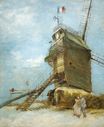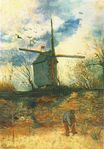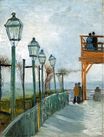Vincent van Gogh - Le Moulin de la Galette 1886
 |
 |
 |
 |
 |
 |
 |

Le Moulin de la Galette 1886
55x38cm oil/canvas
Private collection
<< Previous G a l l e r y Next >>
From Wikipedia, the free encyclopedia:
In 1886 van Gogh left the Netherlands for Paris and the guidance of his brother Theo van Gogh. While van Gogh had been influenced by great Dutch masters, coming to Paris meant that he would have the opportunity to be influenced by Impressionists, Symbolists, Pointillists, and Japanese art. His circle of friends included Émile Bernard, Paul Gauguin, Camille Pissarro, Henri de Toulouse-Lautrec, and others.
Montmartre, sitting on a butte overlooking Paris, was known for its bars, cafes, and dance-hall. It was also located on the edge of countryside that afforded van Gogh the opportunity to work on paintings of rural settings while living in Paris.
The landscape and windmills around Montmartre were the source of inspiration for a number of van Gogh's paintings. Moulin de la Galette, still standing, is located near the apartment that van Gogh shared with his brother Theo from 1886 until 1888. Built in 1622, it was originally called Blute-Fin and belonged to the Debray family in the 19th century. Van Gogh met artists such as Toulouse-Lautrec, Paul Signac and Paul Gauguin who inspired him to incorporate Impressionism into his artwork that, among other things, resulted in lighter, more colorful works of art.
Moulin de la Galette was also the name of an outdoor dance hall that was located between two of the last windmills on a Montmartre hilltop. In addition to van Gogh, Toulouse-Lautrec and Pierre-Auguste Renoir also painted Moulin de la Galette. Renoir's painting of the dance hall is titled Bal du moulin de la Galette.